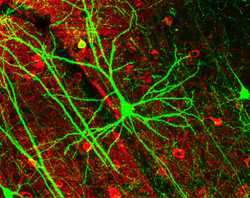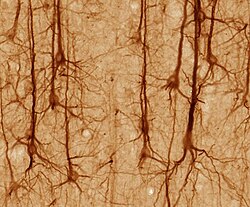Help:Editing
Wikipedia has a detailed guide covering wiki markup that you will likely find helpful. In addition to these commands, the wiki can accept HTML markup. Some functionality that you will need for this course is briefly discussed on this page.
Contents
Text Formatting, Links, and Signatures
Whenever you are editing a page on the wiki, a toolbar will appear that looks like this:
This toolbar provides buttons for creating bold (![]() ) or italic (
) or italic (![]() ) text, inserting links to webpages (
) text, inserting links to webpages (![]() ), and a number of other tasks. In particular, you can sign your wiki edits (
), and a number of other tasks. In particular, you can sign your wiki edits (![]() ), which will leave your name and a timestamp when you save the page. We ask that you use this feature when you write comments on Discussion pages.
), which will leave your name and a timestamp when you save the page. We ask that you use this feature when you write comments on Discussion pages.
Images
Adding Images
By clicking the "Embedded file" button (![]() ), you can insert images into a page. Place your cursor where you would like the image to appear, and press the button. A dialog box will appear allowing you to enter a Filename. We recommend using a file naming scheme like this:
), you can insert images into a page. Place your cursor where you would like the image to appear, and press the button. A dialog box will appear allowing you to enter a Filename. We recommend using a file naming scheme like this: CWRUid-unitname-problemnumber.fileextension, where CWRUid is your Case ID, unitname and problemnumber reference the unit and problem set or term paper benchmark you are currently working on, and fileextension is the extension of the file, such as .png or .jpg.
Additionally, the dialog box will give you the option to create a caption, set the alignment, and choose a size for the image. Please, always include a descriptive caption. You can create large images that appear on the page where you intend them to go if you select "center" for alignment and enter a number, e.g. 400, for the size (this is the width of the image in pixels). We recommend keeping the format "thumbnail".
After you submit the dialog box, a line of text will appear in your page that looks something like this:
[[File:Jpg18-my-awesome-pic.png|400px|thumbnail|center|This image shows...]]
If you insert a new image into a page and save, it will initially appear as a red link on the page. You should click on this link, and you will be given the opportunity to upload the file to the wiki. Once you have done so, make sure that the uploaded file has the same name you used on your wiki page. If it matches, your image should now appear on your wiki page. If it does not match and the red link is still present, change the file name on your wiki page to match the uploaded file name.
Taking Screenshots
To take screenshots of the simulations for your lab notebook, there are simple tools available to Windows and Mac users. Windows 7 users can click on the Start button and search for the Snipping Tool, which lets you select a portion or all of your screen and save the image to your computer. Mac OS X users can press Command-Shift-4, select a portion of their screen, and save the screen capture as a file to the desktop. We recommend saving your images as PNG or JPEG files.
Placing Figures Side-By-Side
If you would like to create nicely formatted figures placed in a row, you can use tables. In this case, it may be better to place captions in a separate table row and to drop the "thumbnail" format (mentioned above) from each image.
Here's an example:
This text is above the figures.
{| align="center" cellspacing="10"
|- style="text-align:center;"
| [[File:PurkinjeCell.jpg|250px|]]
| [[File:GFPneuron.png|250px|]]
| [[File:Smi32neuron.jpg|250px|]]
|- style="vertical-align: top"
| Figure 1: Lorem ipsum dolor sit amet, consectetur adipisicing elit, sed do eiusmod tempor incididunt ut labore et dolore magna aliqua.
| Figure 2: Ut enim ad minim veniam, quis nostrud exercitation ullamco laboris nisi ut aliquip ex ea commodo consequat. Duis aute irure dolor in reprehenderit in voluptate velit esse cillum dolore eu fugiat nulla pariatur.
| Figure 3: Excepteur sint occaecat cupidatat non proident, sunt in culpa qui officia deserunt mollit anim id est laborum.
|-
|}
This text is below the figures.
Here's the result:
This text is above the figures.
This text is below the figures.
Section Headings, Lists, Tables
If you select "Advanced" from the toolbar, you will see a number of additional tools allowing you to add section headings, bulleted (![]() ) or numbered (
) or numbered (![]() ) lists, and tables (
) lists, and tables (![]() ):
):
Further help with tables can be found here and here.
Citations and Footnotes
Please see the Recommended Usage of citation templates below.
If you select "Cite" from the toolbar, you will have access to citation templates that make referencing sources in a uniform style much easier:
Clicking on "Templates" will allow you to cite various types of sources by filling out a form for the resource. For example, if you select "cite journal", you will see the following:
If you give the citation a name by filling in the "Ref name" field, then you will be able to cite the same source elsewhere in your writing by using the "Named references" button (![]() ) on the toolbar:
) on the toolbar:
If you would like to create a simple footnote, you can do so by clicking the "Reference" button (![]() ).
).
Finally, to list all your citations and footnotes at the end of your article, use the <references/> tag or {{reflist}} template.
Recommended Usage
You can place all the code for your citations in a bibliography section at the end of your document. This allows you to avoid mixing citation code with your prose. You can construct your bibliography like this:
==Sources==
{{reflist|refs=
(citation templates go here)
}}
Don't forget to include the closing curly braces. You can then place your cursor between the two lines of code (where it says "citation templates go here") and select a citation template from the "Cite" toolbar. Fill out the form (be sure to include a "Ref name") and press "Insert". Some code will be inserted in the location of your cursor. You can insert as many citations as you like in this way.
Once you have filled out a citation template for a source, you can refer to that source in your document. Place the cursor in the location you would like to provide the citation (perhaps at the end of a sentence), and press the "Named references" button (![]() ). Choose the named reference you want to cite, and press "Insert".
). Choose the named reference you want to cite, and press "Insert".
Here's an example of how you can structure your document with citation templates:
The sketch in the wiki logo is of a Purkinje neuron taken from cerebellar
cortex in cat, created by Santiago Ramón y Cajal.<ref name="cajal"/>
The trace is of a microelectrode recording obtained from a Purkinje neuron
in rat. The neuron was stimulated with a depolarizing current, and it responded
by producing a train of action potenitals.<ref name="akemann"/>
'''Bibliography'''
{{reflist|refs=
<ref name="cajal">
{{cite web
| last = Ramón y Cajal
| first = Santiago
| title = Purkinje cell by Cajal
| url = http://commons.wikimedia.org/wiki/File:Purkinje_cell_by_Cajal.png
| publisher = WikiMedia Commons
| accessdate = 18 August 2012
}}
</ref>
<ref name="akemann">
{{cite journal
| last1 = Akemann
| first1 = Walther
| last2 = Middleton
| first2 = Steven J
| last3 = Knöpfel
| first3 = Thomas
| title = Optical imaging as a link between cellular neurophysiology and circuit modeling
| journal = Frontiers in Cellular Neuroscience
| date = 2009
| volume = 3
| doi = 10.3389/neuro.03.005.2009
| url = http://dx.doi.org/10.3389/neuro.03.005.2009
| accessdate = 18 August 2012
}}
</ref>
}}
The result is:
The sketch in the wiki logo is of a Purkinje neuron taken from cerebellar cortex in cat, created by Santiago Ramón y Cajal.[1]
The trace is of a microelectrode recording obtained from a Purkinje neuron in rat. The neuron was stimulated with a depolarizing current, and it responded by producing a train of action potenitals.[2]
Bibliography
- ↑ Ramón y Cajal, Santiago. "Purkinje cell by Cajal". WikiMedia Commons. Retrieved 18 August 2012.
- ↑ Akemann, Walther; Middleton, Steven J; Knöpfel, Thomas (2009). "Optical imaging as a link between cellular neurophysiology and circuit modeling". Frontiers in Cellular Neuroscience. 3. doi:10.3389/neuro.03.005.2009. Retrieved 18 August 2012.
Highlighted Text
HTML code is required for highlighting text. Here is an example:
<span style="background:yellow">Our hypothesis is...</span>
The result is:
Our hypothesis is...
Math and Equations
- Equations and symbols can be displayed using the
<math>...</math>tags with LaTeX markup.
- Subscripts can be created in wiki math using underscores (e.g.
<math>k_{12}</math>), and superscripts can be created using carets (e.g.<math>10^{-4}</math>).
- Wikipedia has a comprehensive guide containing lists of commands that you can use when building equations.
- There are many other resources on the web for help with LaTeX markup that you may also find useful.
- Combine wiki math with tables for effective equation and parameter presentation.
Example 1
<math>
\frac{dx}{dt} = f(x)
</math>

Example 2
<math>
x_{0} =
\begin{pmatrix}
\alpha & \beta \\
\gamma & \delta \\
\end{pmatrix}
</math>

Example 3
<math>
J =
\begin{pmatrix}
\frac{\partial f}{\partial x} & \frac{\partial f}{\partial y} \\
\frac{\partial g}{\partial x} & \frac{\partial g}{\partial y} \\
\end{pmatrix}
</math>

Example 4
<math>
E_{\text{ion}} = \frac{RT}{z\mathcal{F}} \ln \frac{[\text{ion}]_{\text{out}}}{[\text{ion}]_{\text{in}}}
</math>
![E_{\text{ion}} = \frac{RT}{z\mathcal{F}} \ln \frac{[\text{ion}]_{\text{out}}}{[\text{ion}]_{\text{in}}}](/w/images/math/d/5/6/d56cb0396a0492a70d028a376d3a0da9.png)
Example 5 (compare to Example 1)
You can center an equation using display="block".
<math display="block">
\frac{dx}{dt} = f(x)
</math>

Example 6
You can create a series of equations by stringing math tags together.
<math display="block">
\frac{dx}{dt} = f(x,y,z)
</math>
<math display="block">
\frac{dy}{dt} = g(x,y,z)
</math>
<math display="block">
\frac{dz}{dt} = h(x,y,z)
</math>



Example 7
You can even create a step-by-step calculation using the align environment. In the next example, the &'s mark the position on each line that should be aligned with the other &'s, and the \\'s indicate a line break.
<math display="block">
\begin{align}
x &= 4 + 3 \times (5 + 8) \\
&= 4 + 3 \times 13 \\
&= 4 + 39 \\
&= 43 \\
\end{align}
</math>

Example 8
Create piecewise functions using the cases environment. Like the previous example, the &'s mark the position on each line that should be aligned with the other &'s, and the \\'s indicate a line break.
<math display="block">
|x| =
\begin{cases}
-x, & \text{if } x < 0, \\
x, & \text{if } x \ge 0. \\
\end{cases}
</math>

Mathematica Notebooks
Links to Mathematica notebooks can be created using [[Media: ...]].
If you add a new media link into a page and save, it will initially appear as a red link. If you click on this link, you will be given the opportunity to upload the file to the wiki. IMPORTANT: Please prefix your CWRU network ID to the names of your files to ensure they are unique!
For example, you can create a link to a file named "Chapter02.nb" with the text "BIOL 300: Chapter 2" this way:
[[Media: Chapter02.nb | BIOL 300: Chapter 2]]







